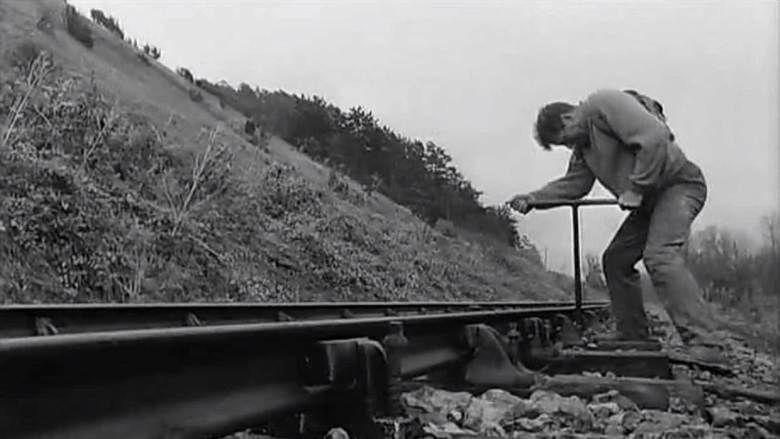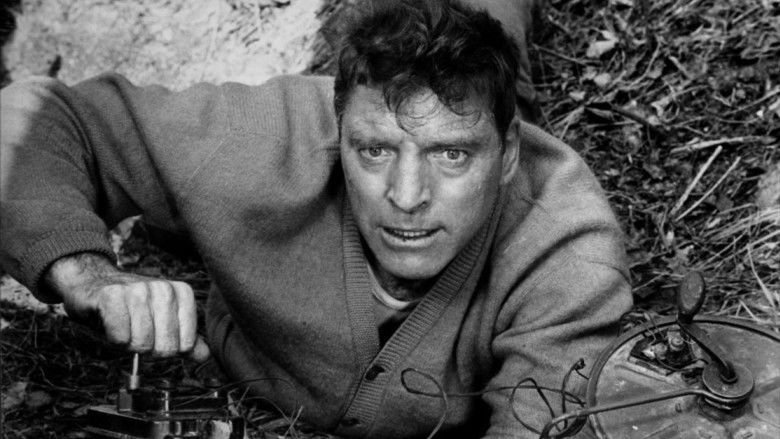The Train (1964 film)
8 /10 1 Votes
Duration Language English | 8/10 IMDb Genre Thriller, War, Action Budget 6.7 million USD Country United StatesFranceItaly | |||||||||||||||||||||||||||||||||
 | ||||||||||||||||||||||||||||||||||
Release date 1964 (UK)March 7, 1965 (U.S.) Based on Le front de lart byRose Valland Writer Franklin Coen (screen story), Frank Davis (screen story), Franklin Coen (screenplay), Frank Davis (screenplay), Rose Valland (book) Cast (Paul Labiche), (von Waldheim), (Christine), (Mademoiselle Villard), (Papa Boul), (Maj. Herren) Similar movies Fury , Captain America: The First Avenger , Saving Private Ryan , When Trumpets Fade , Hell Is for Heroes , Tagline It carried their hopes, their nation's honour! | ||||||||||||||||||||||||||||||||||
The Train is a 1964 war film directed by John Frankenheimer from a story and screenplay by Franklin Coen and Frank Davis, inspired by the non-fiction book Le front de l'art by Rose Valland, who documented the works of art placed in storage that had been looted by the Germans from museums and private art collections. It stars Burt Lancaster, Paul Scofield and Jeanne Moreau.
Contents
- The train 10 10 movie clip a lump of flesh 1964 hd
- Plot
- Historical background
- Production
- Locations
- The circular journey
- Locomotives used
- Reception
- Awards and honors
- References

Set in August 1944, the film, an American-French-Italian co-production which was shot in black-and-white, sets French Resistance-member Paul Labiche (Lancaster) against German Colonel Franz von Waldheim (Scofield), who is attempting to move stolen art masterpieces by train to Germany. Inspiration for the scenes of the train's interception came from the real-life events surrounding train No. 40,044 as it was seized and examined by Lt. Alexandre Rosenberg of the Free French forces outside Paris.

The train 10 10 movie clip a lump of flesh 1964 hd
Plot

In 1944, masterpieces of modern art stolen by the Wehrmacht are being shipped to Germany; the officer in charge of the operation, Colonel Franz von Waldheim (Paul Scofield), is determined to take the paintings to Germany, no matter the cost. After the works chosen by Waldheim are removed from the Jeu de Paume Museum, curator Mademoiselle Villard (Suzanne Flon) seeks help from the French Resistance. Given the imminent liberation of Paris by the Allies, they need only delay the train for a few days, but it is a dangerous operation and must be done in a way that does not risk damaging the priceless cargo.

Resistance cell leader and SNCF area inspector Paul Labiche (Burt Lancaster) initially rejects the plan, telling Mlle. Villard and senior Resistance leader Spinet (Paul Bonifas), "I won't waste lives on paintings"; but he has a change of heart after a cantankerous elderly engineer, Papa Boule (Michel Simon), is executed for trying to sabotage the train on his own. After that sacrifice, Labiche joins his Resistance teammates Didont (Albert Rémy) and Pesquet (Charles Millot), who have been organizing their own plan to stop the train with the help of other SNCF Resistance members. They devise an elaborate ruse to reroute the train, temporarily changing railway station signage to make it appear to the German escort as if they are heading to Germany when they have actually turned back toward Paris. They then arrange a double collision in the small town of Rive-Reine that will block the train without risking the cargo. Labiche, although shot in the leg, escapes on foot with the help of the widowed owner of a Rive-Reine hotel, Christine (Jeanne Moreau), while other Resistance members involved in the plot are executed.
The night after the collision, Labiche and Didont meet Spinet again, along with young Robert (the nephew of Jacques, the executed Rive-Reine station master) and plan to paint the tops of three wagons white to warn off Allied aircraft from bombing the art train. Robert recruits railroad workers and friends of his Uncle Jacques from nearby Montmirail, but the marking attempt is discovered, and Robert and Didont are both killed.
Now working alone, Labiche continues to delay the train after the tracks are cleared, to the mounting rage of von Waldheim. Finally, Labiche manages to derail the train without endangering civilian hostages that the colonel has placed on the locomotive to prevent it being blown up. Von Waldheim flags down a retreating army convoy and learns that a French armoured division is not far behind. The colonel orders the train unloaded and attempts to commandeer the trucks, but the officer in charge refuses to obey his orders. The train's small German contingent kills the hostages and joins the retreating convoy.
Von Waldheim remains behind with the abandoned train. Crates are strewn everywhere between the tracks and the road, labelled with the names of famous artists. Labiche appears and the colonel castigates him for having no real interest in the art he has saved:
Does it please you, Labiche? You feel a sense of excitement at just being near them? A painting means as much to you as a string of pearls to an ape. You won by sheer luck. You stopped me without knowing what you were doing or why.... The paintings are mine. They always will be. Beauty belongs to the man who can appreciate it. They will always belong to me, or a man like me. Now, this minute, you couldn't tell me why you did what you did.
In response, Labiche turns and looks at the murdered hostages. Then, without a word, he turns back to von Waldheim and shoots him. Afterwards he limps away, leaving the corpses and the art treasures where they lie.
Historical background
The Train is based on the factual 1961 book Le front de l'art by Rose Valland, the art historian at the Galerie nationale du Jeu de Paume, who documented the works of art placed in storage there that had been looted by the Germans from museums and private art collections throughout France and were being sorted for shipment to Germany in World War II.
In contrast to the action and drama depicted in the film, the shipment of art that the Germans were attempting to take out of Paris on August 1, 1944, was held up by the French Resistance with an endless barrage of paperwork and red tape and made it no farther than a railyard a few miles outside Paris.
The train's actual interception was inspired by the real-life events surrounding train No. 40,044 as it was seized and examined by Lt. Alexandre Rosenberg of the Free French forces outside Paris in August 1944. Upon his soldiers opening the wagon doors he viewed many plundered pieces of art that had once been displayed in the home of his father, Parisian art dealer Paul Rosenberg, one of the world's major Modern art dealers.
German veterans' organisations, including the SS veterans' group HIAG, objected to Wehrmacht soldiers being depicted executing hostages and Resistance members in the film. They said that SS or uniformed Sicherheitspolizei (the Sicherheitsdienst and Gestapo) personnel should have been used for those scenes.
Production
John Frankenheimer took over the film from another director, Arthur Penn. Burt Lancaster had Penn fired after three days of filming in France, and called in Frankenheimer to take over. Penn envisioned a more intimate film that would muse on the role art played in Lancaster's character, and why he would risk his life to save the country's great art from the Nazis. He did not intend to give much focus to the mechanics of the train operation itself. But Lancaster wanted more emphasis on action to ensure that the film would be a hit, after the failure of his film The Leopard. The production was shut down briefly while the script was rewritten, and the budget doubled. As he recounts in the Champlin book, Frankenheimer used the production's desperation to his advantage in negotiations. He demanded and got the following: his name was made part of the title, "John Frankenheimer's The Train"; the French co-director, demanded by French tax laws, was not allowed to ever set foot on set; he was given total final cut; and a Ferrari. Much of the film was shot on location.
The Train contains multiple real train wrecks. The Allied bombing of a rail yard was accomplished with real dynamite, as the French rail authority needed to enlarge the track gauge. This can be observed by the shockwaves travelling through the ground during the action sequence. Producers realized after filming that the story needed another action scene, and reassembled some of the cast for a Spitfire attack scene that was inserted into the first third of the film. French Armée de l'Air Douglas A-26 Invaders are also seen later in the film.
The film includes a number of sequences involving long tracking shots and wide-angle lenses, with both foreground and background action in focus. Noteworthy tracking shots include:
During an interview with the History Channel, Frankenheimer revealed:
Frankenheimer remarked on the DVD commentary, "Incidentally, I think this is the last big action picture ever made in black and white, and personally I am so grateful that it is in black and white. I think the black and white adds tremendously to the movie."
Throughout the film, Frankenheimer often juxtaposed the value of art with the value of human life. A brief montage ends the film, intercutting the crates full of paintings with the bloodied bodies of the hostages, before a final shot shows Labiche walking away.
Locations
Filming took place in several locations, including: Acquigny, Calvados; Saint-Ouen, Seine-Saint-Denis; and Vaires, Seine-et-Marne. The shots span from Paris to Metz. Much of the film is centered in the fictional town called "Rive-Reine."
The circular journey
Actual train route: Paris, Vaires, Rive-Reine, Montmirail, Chalon-S-Marne, St Menehould, Verdun, Metz, Pont-a-Mousson, Sorcy (Level Crossing), Commercy, Vitry Le Francois, Rive-Reine.
Planned route from Metz to Germany: Remilly, Teting (Level Crossing), St Avold, Zweibrücken.
Locomotives used
The locomotives used were the former Chemins de fer de l'Est Series 11s 4-6-0s, which the SNCF classified as 1-230.B. Identifiable locomotives include 1-230.B.739 with tender 22.A.739, 1-230.B.616, and 1-230.B.855 with tender 22.A.886; Papa Boule's locomotive is 1-230.B.517; and SNCF Class 030TUs can be seen in background shots. In the crash scene, an ancient "Bourbonnais" type 030.C 0-6-0 (N° 757) is used to block the line. In the yard scenes, some SNCF Class 141R engines can be seen parked on sidings, however, engines of this class were not built until after the war as part of the railway's reconstruction.
Reception
The Train earned $3 million in the US and $6 million elsewhere. It had cost $6.7 million. The film was one of the 13 most popular films in the UK in 1965.
The Train holds a 100% "Fresh" rating on Rotten Tomatoes (although it does show one negative review), and a score of 7.9/10 on the Internet Movie Database.
Awards and honors
References
The Train (1964 film) WikipediaThe Train (1964 film) IMDb The Train (1964 film) themoviedb.org
